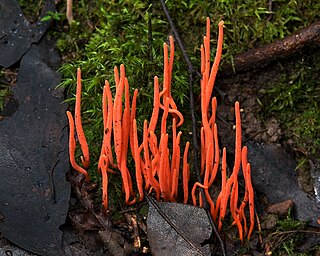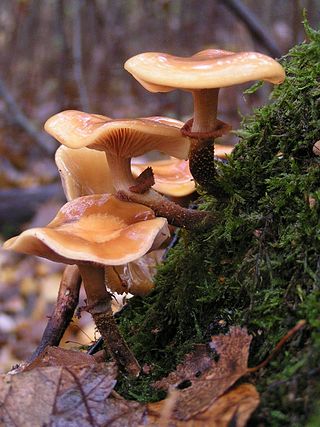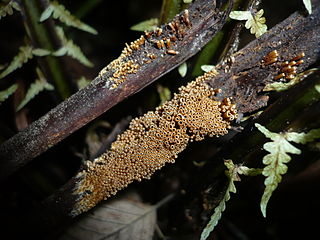
The Agaricales are an order of fungi in the division Basidiomycota. As originally conceived, the order contained all the agarics, but subsequent research has shown that not all agarics are closely related and some belong in other orders, such as the Russulales and Boletales. Furthermore, DNA research has shown that many non-agarics, including some of the clavarioid fungi and gasteroid fungi belong within the Agaricales. The order has 46 extant families, more than 400 genera, and over 25,000 described species, along with six extinct genera known only from the fossil record. Species in the Agaricales range from the familiar Agaricus bisporus and the deadly Amanita virosa to the coral-like Clavaria zollingeri and bracket-like Fistulina hepatica.

The Hygrophoraceae are a family of fungi in the order Agaricales. Originally conceived as containing white-spored, thick-gilled agarics, including Hygrophorus and Hygrocybe species, DNA evidence has extended the limits of the family, so it now contains not only agarics, but also basidiolichens and corticioid fungi. Species are thus diverse and are variously ectomycorrhizal, lichenized, associated with mosses, or saprotrophic. The family contains 25 genera and over 600 species. None is of any great economic importance, though fruit bodies of some Hygrocybe and Hygrophorus species are considered edible and may be collected for sale in local markets.

The Clavariaceae are a family of fungi in the order Agaricales. Originally the family contained most of the clavarioid fungi, but in its current sense is more restricted, albeit with a greater diversity of basidiocarp forms. Basidiocarps are variously clavarioid or agaricoid (mushroom-shaped), less commonly corticioid or hydnoid.

Kuehneromyces is a genus of agaric fungi in the family Strophariaceae. The genus was circumscribed by mycologists Rolf Singer and Alexander H. Smith in 1946.

The Tricholomataceae are a large family of fungi within the order Agaricales. Originally a classic "wastebasket taxon", the family included any white-, yellow-, or pink-spored genera in the Agaricales not already classified as belonging to e.g. the Amanitaceae, Lepiotaceae, Hygrophoraceae, Pluteaceae, or Entolomataceae.

Pleosporaceae is a family of sac fungi. The taxonomic relationship of this family to associated genera is still not determined.
The Didymosphaeriaceae are a family of fungi in the order Pleosporales. The family was erected by Anders Munk in 1953.

The Pyrenulales are an order of ascomycetous fungi within the class Eurotiomycetes and within the subphylum Pezizomycotina.
The Halosphaeriaceae are a family of fungi in the Sordariomycetes class, subclass Hypocreomycetidae. As of 2015, Halosphaeriaceae is the family with the largest number of marine fungi, with 141 species distributed among 59 genera.

The Bionectriaceae are a family of fungi in the order Hypocreales. A 2008 estimate places 35 genera and 281 species in the family. Species in the family tend to grow on plant material, including woody debris, while some species associate with algae, bryophytes, or other fungi.
The Lulworthiaceae are a family of marine fungi in the Ascomycota, class Sordariomycetes. Species in the family have a widespread distribution in both temperate and tropical oceans, and are typically found growing on submerged wood or on seaweed. In 2000, Molecular analysis of several species of Lulworthia and Lindra led to the reassignment of their parent genera to the new order Lulworthiales in addition to the new family Lulworthiaceae. In 2020, a large fungi study added more genera to the family.
Episphaeria is a genus of fungus in the Agaricales. The genus is monotypic, and contains the single rare species Episphaeria fraxinicola, found in Europe. Its familial position is not known with certainty. The tiny fruit bodies of the fungus resemble minute, white cups that grow scattered or in groups on the bark of ash trees.

Woldmaria is a fungal genus in the family Niaceae. The genus is monotypic, containing the single species Woldmaria filicina, found in Europe and North America. Woldmaria was described by William Bridge Cooke in 1961, with Woldmaria crocea as the type species; it was subsequently moved into synonymy with W. filicina.
Digitatispora is a genus of crustlike marine fungi. While previously placed in the order Atheliales, molecular studies have concluded that Digitatispora belongs in the Agaricales, within the family Niaceae. The genus, circumscribed by French mycologist Gaston Doguet in 1962, contains two wood-decaying species that grow on marine-submerged wood.
Lichenoverruculina is a fungal genus in the family Hyponectriaceae and order Amphisphaeriales. This is a monotypic genus, containing the single species Lichenoverruculina sigmatospora. which was published in Herzogia vol.24 (2) on page 274 in 2011.









